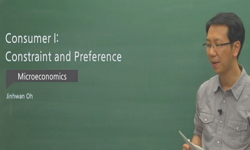
-
- 주제분류
- 사회과학 >경영ㆍ경제 >경제학
-
- 강의학기
- 2018년 1학기
-
- 조회수
- 13,177
-
- 평점
- 5/5.0 (2)
- 강의계획서
- 강의계획서
<교재 및 출처>
- Intermediate Microeconomics 9th edition by Hal R. Varian (It is fine if you use an older edition.)
- Freakonomics by Steven Levitt and Stephen Dubner. Ch. 1 (Incentive)
- What Money Can’t Buy by Michael Sandel. Introduction and Ch. 1 (Efficiency vs.Equality)
- Predictably Irrational by Dan Ariely Ch. 1, 2 (Behavioral Economics)
- Undercover Economist by Tim Harford. Ch. 2 (Price Discrimination), Ch. 5 (Asymmetric Information)
- Economics: The User’s Guide by Ha-joon Chang (Ch. 1)
- International Economics 2nd editionby Robert Feenstra and Alan Taylor (Ch.2,3,4,5)
- Intermediate Microeconomics 9th edition by Hal R. Varian (It is fine if you use an older edition.)
- Freakonomics by Steven Levitt and Stephen Dubner. Ch. 1 (Incentive)
- What Money Can’t Buy by Michael Sandel. Introduction and Ch. 1 (Efficiency vs.Equality)
- Predictably Irrational by Dan Ariely Ch. 1, 2 (Behavioral Economics)
- Undercover Economist by Tim Harford. Ch. 2 (Price Discrimination), Ch. 5 (Asymmetric Information)
- Economics: The User’s Guide by Ha-joon Chang (Ch. 1)
- International Economics 2nd editionby Robert Feenstra and Alan Taylor (Ch.2,3,4,5)
차시별 강의






| 1. |  |
Constraint (Ch. 2) | This lecture first reviews the overall structure of the consumer theory and explains budget constraint and its changing shape as an example of scarcity |  |
 |
Preferences (Ch. 3) | Understands 6 axioms to derive the theory of consumer preference and examines the shape of indifference curves, different kinds of preferences, and marginal rate of substitution |  |
|
 |
Utility (Ch. 4) | Introduces utility functions to mathematically represent theory of preferences and revisit marginal utility and marginal rate of substitution using calculus |  |
|
| 2. |  |
Utility II (Ch. 4) | Shows that preference relations are ordinally maintained under monotonic transformations |  |
 |
Optimization (Ch. 5) | Find optimal consumption bundles through maximizing utility subject to budget constraint, through which a demand curve is derived. In addition, several propertities of the Cobb-Douglas utility function is examined. |  |
|
 |
Optimization II (Ch. 5) | Revisit the constrained optimization using utility functions represented by other preference relations - perfect substitutes and perfect complements |  |
|
| 3. |  |
Demand and Slutsky II (Ch. 6, 8) | From the optimal consumption bundles, this lecture derives a demand curve and many other important curves, as well as the Slutsky Equation |  |
 |
Demand and Slutsky II (Ch. 6, 8) | The Slutsky Equation will derive Marshallian and Hicks Demand, which are analyzed depending on whether goods are normal, inferior, and Giffen. The case of perfect complements will be discussed as well. |  |
|
 |
Consumer Surplus (Ch. 14) | Discusses compensating variation based on the Hicks demand and compares it with the change of consumer surplus. Reviews problem set questions based on Cobb Douglas preference and perfect complements |  |
|
| 4. |  |
Technology (Ch. 19) | Introduces producer theory as opposed to consumer part. Using the Cobb-Douglas production function, this lecture examines diminishing marginal products, as well as decreasing, constant, and increasing returns to scale |  |
 |
Profit Maximization (Ch. 20) | Introduces profit maximization subject to production constraint, and, using short-run 1 input 1 output model (Ix1), this lecture derives optimal solution for input and output, known as labor demand and output supply. |  |
|
 |
Cost Minimization (Ch. 21) | Profit maximization is revisited through cost minimization with 1x2 model and examines the relationship between returns to scale and cost funciton |  |
|
| 5. |  |
Problem Set Review | Understands how microeconomic theories are applied to International trade theories (e.g. Ricardian Model and short-run Specific Factors Model where capital is fixed) |  |
 |
Cost Curves (Ch. 22) | Inrdoduces concepts like fixed cost, variable cost, average cost, and relate them with returns to scale. Provide graphical explanations on profit and shutdown points |  |
|
 |
Perfect Competition (Ch. 23. 24) | Examine a perfectly competitive market with price takes and free entry/exit, and go over profit maximization where price is same as the marginal cost |  |
|
 |
Application: Specific Factors Model | Examine the Specific Factors Model based on the perfect competition and the constant returns to scale, and use Korea-US and Korea-China FTA as examples for gain and loss from trade. |  |
|
| 6. |  |
Monopoly I (Ch. 25) | Examines the profit maximizing condition of a monopoly firm where marginal revenue is equal to marginal cost and find an equilibrium, an area of profit and deadeweigt loss in the graph with demand, average cost, and marginal cost. Find another deadweight loss and inefficient resource allocation in the case of tariff |  |
 |
Monopoly II (Ch. 25) | Review a problem set question to compare a monopolist's profit maximizing level of equilibrium with socially optimal choice, and discusses the importance of both patent and generic medicines. |  |
|
 |
Monopolistic Competition (Ch. 26) | Monopolisitc competition is introduced as opposed to perfect competition and monopoly, with particular reference to zero profit and market power of firms. Combined with increasing returns to scale, monopolistic competition also explains agglomeration in economic geography and median voter theorem in political economy. |  |
|
 |
Application: New Trade Theory | Inroduces Paul Krugman's New Trade Theory as another example of monopolistic competition and incresing returns to scale to explain product differetiation and intra-industry trade. Derives gains from trade from the fact varieties make consumer demand more elastic. |  |
|
| 7. |  |
General Equilibrium I | Extend the topic from partial to general equilibrium analysis. Provide alebraic explanations on how to find equilibrium in a pure exchange economy |  |
 |
General Equilibrium II (Ch. 9, 32) | Intoduces the Edgeworth Box and draws initial endowments, budget, buying and selling, equilibrium, and mutual utility improvement in the box. Explains the Walras' Law, as well. |  |
|
 |
General Equilibrium III (Ch. 9, 32) | Introduces the First Fundamentatl Theorem of Welfare Economics in which equilibrlium in efficient under certain conditions, and visualize this on the Edgeworth Box using the contract cuve where MRS of the two people's utility functions are equalized. Briefly mentions the tradeoffs between efficiency and equality, and provide several examples based on different kinds of utility functions |  |
|
| 8. |  |
General Equilibrium IV (Ch. 33) | Takes production part into considerations. A set of efficient allocation of labor and capital is derived where MRTS of two production functions are equalized. A PPF is derived from here. |  |
 |
General Equilibrium V (Ch. 33) | An Edgeworth Box is provided inside the PPF to explain how goods produced on the PPF are consumed by two consumers. Finds the economy-wide efficiency where consumers' MRS is equal to the slope of PPF, known as marginal rate of transformation (MRT) |  |
|
 |
Application to International Trade I | Going over problem set question on the Specific Factors Model of International Trade, based on general equilibrium |  |
|
 |
Application to International Trade II | Examines, using general equilibrium theories, the long-run and short-run impact of immigration on real wage of domestic workers. Briefly introduces the Rybczynski Theorem. |  |
|
| 9. |  |
Game Theory I | Introduces game elements and Nash Equilibrium. Also introduces the prisoners' dilemma game as an example of simultaneous non-cooperative game, and explains that individually best strategy may turn out to be not the best for the group |  |
 |
Game Theory II | Examines multiple Nash Equilibrium and mixed strategy Nash Equilibrium, and show that equilibrium does exist |  |
|
 |
Game Theory III | Reviews problem set questions, including nuclear power game as a prisoners' dilemma and coordinated investment game for the big push from development economics |  |
|
| 10. |  |
Game Theory IV | Introduces the backward induction and subgame perfect equilibrium in a sequential game. Examines Nash Equilibrium as the self-fulling prophesy and relate "belief" with "perfect" |  |
 |
Game Theory V | Introduces the Cournot Nash Equilibrium as a part of oligopolistic behavior, and examines why cartel through collusion is vulnerable |  |
|
 |
Game Theory VI | Examines the Stackelberg Equilibrium between leaders and followers in a sequential game, and briefly introduces asymmetric information and adverse selection as another field of economics dealing with imperfect information |  |
연관 자료

이용방법
-
플래쉬 유형 강의 이용시 필요한 프로그램 [바로가기]
강의가 나오지 않을 때 인터넷 익스플로러의 인터넷 메뉴 - 도구 - 호환성 보기 설정-이 웹 사이트 추가에 ewha.ac.kr 추가
※ 강의별로 교수님의 사정에 따라 전체 차시 중 일부 차시만 공개되는 경우가 있으니 양해 부탁드립니다.










